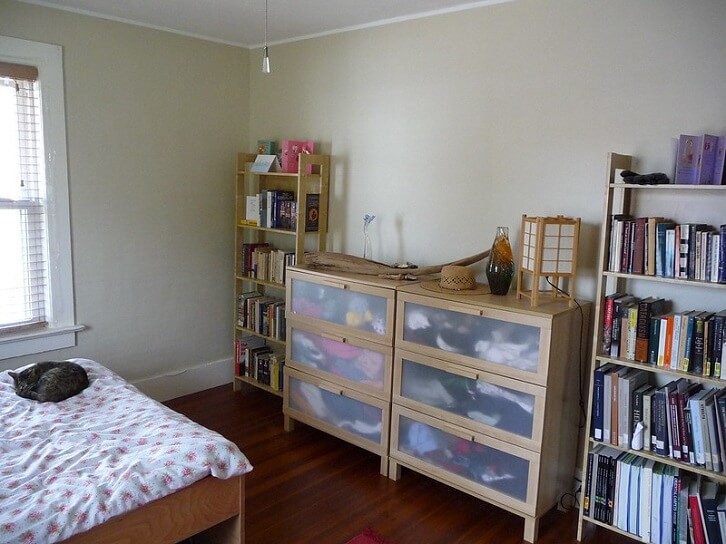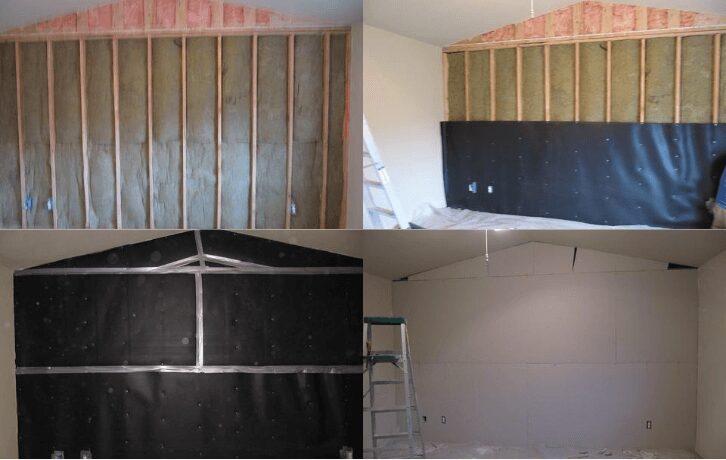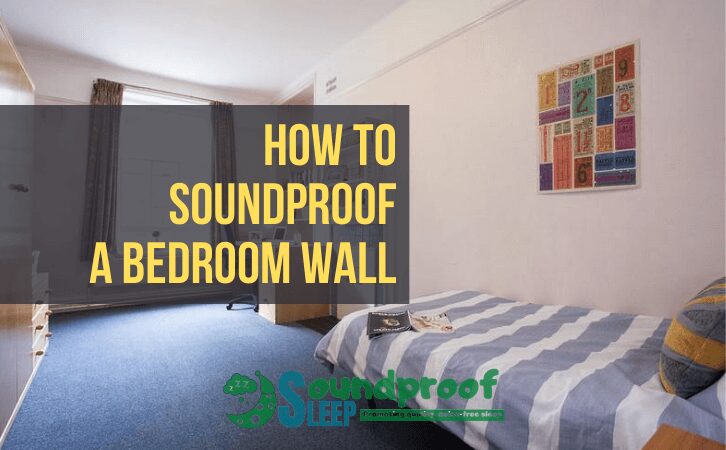The hardest part of achieving 100% fully soundproofed bedroom or home is when it comes to dealing with walls and floors. For walls, most houses or rented units use cheap partition walls in their construction. Because soundproofing is not taken into consideration when constructing the wall, noise transmission between walls is inevitable.
To properly soundproof an existing wall you can use mass, absorption, or build an extra wall. Let’s go into more details below.
How to Soundproof Existing Bedroom Wall
- Fill up Empty Space
- Find Cracks and Holes around the Wall
- Add Mass to the Walls
- Add a Second Layer of Drywall
[sta_anchor id=”fill-up-empty-space”]1. Fill up Empty Space[/sta_anchor]
Before you undertake a soundproofing project, consider the room. Sometimes, the problem is that the room is sparsely furnished, which causes the sound to reverberate around.
This amplifies even the smallest of sounds, making them louder than they are. To fix this, adding furniture (mostly upholstered furniture), or bookshelves, can absorb sound and reduce the nature of echos.

Adding objects as close as possible to the wall will not reduce sound from penetrating the room, but it will muffle and reduce the intensity of the sound that enters the room.
[sta_anchor id=”find-cracks-and-holes-around-wall”]2. Find Cracks and Holes around the Wall[/sta_anchor]
Noise, like air, passes through even the smallest holes and cracks around a wall.
Caulking is the best solution for dealing with holes and cracks. Look closely at the wall and mark as many cracks and holes as possible. Electrical boxes, outlets, and switches should also be sealed to prevent sound from penetrating via the boxes and drywall.
A good noise proofing sealant like the Green Glue Noiseproofing Sealant is a good choice for the job. It is flexible, does not crack or shrink over time, thus offering a permanent solution. The Sashco Big Stretch Acrylic Latex caulking sealant is also a solid option you can check out. Be sure to get a caulking gun is you do not have one at your disposal.
[sta_anchor id=”add-mass-to-walls”]3. Add Mass to the Walls[/sta_anchor]
Adding mass to the walls is one of the best ways you can soundproof an existing wall.
One way of doing this is by adding mass-loaded vinyl (MLV) barriers. MLV is a flexible material that comes in rolls of 4-foot wide and can be hanged on walls to help deaden sound. MLV can be nailed directly to walls or glued over them. Make sure it is cut properly to avoid noise escaping and absorb external sound sources.
Also, make sure to properly cut tightly around outlets and switches where sound can penetrate. This also eliminates the need for sound outlet gaskets and helps insulate your home and save.
For a better finish and better results, adding a drywall layer over the MLV goes along way. The TMS Mass Loaded Vinyl or Soundsulate Mass Loaded Vinyl are both good options I have used before.

Hanging acoustic fabric panels, soundproofing blankets, or putting up soundproof curtains can also add mass to the walls and help lessen the intensity of sound entering a room.
Other sound absorption materials like foam panels can also be added to the to muffle noise.
[sta_anchor id=”add-a-second-layer-of-drywall”]4. Add a Second Layer of Drywall[/sta_anchor]
Sound travels in the form of vibrations. If you want to properly soundproof a wall, deadening these vibrations is the best way to stop noise in its tracks.
Adding a second layer of drywall is the easiest method of building a thick wall barrier and stop sound. You do not need to add drywall everywhere. In a bedroom, for example, consider the walls facing outside or the living room and work on them.
Adding whisper clips and headrails or resilient sound clips between the drywall will further stop vibrations from traveling through the wall.
Another option of blocking sound using drywall is using two layers of drywall with green glue sandwiched. The caulk absorbs the vibrations and turn them into heat preventing them from traveling from one layer of the drywall to the other.
First, install the first layer of drywall to the existing wall. After that, properly apply green glue to the back of the second layer of drywall and screw it onto the wall where the first drywall is installed. This process is known as the caulk sandwich.
Alternatively, if you already have drywall installed, then applying green glue over the existing wall and adding drywall over is not a problem, and there will be no performance issues.
Wrapping Up
All suggestions we have outlined above should help block or reduce noise spilling into your home or home through the wall. There are other methods such a building soundproof walls or room within a room that works better but cost more.
If you want to soundproof more than the walls, check out of guides on window soundproofing, door soundproofing, and overall room soundproofing.
Have you ever soundproofed a wall? Comment below with some of your ideas and quick fixes that worked in your case and help other users get better results.

